Related Articles

Animal Tracks to Find With Your Kids + Printable Field Guide
Animal tracks are a great way to learn about the different creatures in your area –– no matter where you live, there are so many cool creatures to discover! Have your little ones turn on their thinking caps and get ready to become an expert animal tracker with the help of this guide.
Learning about animal tracks will encourage your kids’ love of nature and sense of adventure!
How to Find Animal Tracks with Your Kids

Finding animal tracks with your family is a great way to spend an afternoon in the great outdoors! To help you and your little ones get started, read through these helpful tips on finding and identifying the tracks you may see, or jump to the list of tracks here!
It’s important to protect nature wherever you go! Keep yourself, your family and the animals around you safe by keeping these things in mind:
- Never get close to a wild animal –– even if it looks friendly or tries to approach you.
- Leave it where you found it –– don’t take things out of nature that belong there.
- Don’t leave trash behind –– pick up after yourself if you bring snacks along.
- Always practice caution –– be wary of dangerous animals like bears while tracking.
Where to Look
When searching for animal tracks, it’s important to know where to look! Depending on where you live and the season, it may be tricky to track down footprints left by mystery creatures!
Remember to look for these ground types when looking for animal tracks:
- Snow: A thin layer of soft snow is great when looking for tracks made by bigger animals like bears, moose and mountain lions!
- Mud: If you see mud, there may be a body of water nearby. Muddy ground is a great place to look for tracks made by animals like ducks, beavers, turtles and other water-loving beasts!
- Sand: Just like mud, the sandy banks of a river or lake are perfect for spotting the tracks of water birds, animals hoping to get a cool drink of water or a family of bears having an afternoon swim!
- Dirt: Soft, damp soil is ideal for identifying the tracks of animals with paws! If you’re lucky, you may discover a raccoon, opossum or even a bobcat that has been by recently!
What to Look For
There are other ways to tell if an animal has been wandering around! While looking for tracks, make note of these trail features:
- Claw marks and scratches: Some animals (like cats) may leave claw marks on tree stumps or the ground when roaming their territory.
- Broken twigs and leaves: Bigger animals tend to leave a trail of damaged plants behind them. Bears, moose and wolves may be responsible for broken vegetation!
- Scat and waste: Droppings are a great way to identify animals in the area! The size, shape and contents of an animal’s scat can clue you in to its identity!
What to Bring With You

Every great animal tracker knows that it’s important to bring the right outdoor gear, and even some toys if you’re headed camping! Don’t forget to bring these important things with you on your next animal tracking excursion:
- Animal Tracks Field Guide
- Water bottles
- Backpack
- Flashlight
- Camera
Printable Animal Tracks Field Guide
Before setting out to discover animal tracks with the kiddos, be sure to print out this Animal Tracks Field Guide! It will help you identify different tracks when you’re on the trail of a mysterious creature!
Instructions:
- Download the field guide pages and print them on standard paper or cardstock.
- Stack the pages neatly and punch a hole in the top corner.
- Use string or twine to bind the pages together.
Animal Tracks to Find With Your Kids
North America is home to some of the most familiar faces in the animal world –– from whitetail deer to bald eagles and black bears, most people have seen them all! But when wandering through your own backyard, could you figure out what sort of creature left that big paw print in the dirt? Was it your friendly golden retriever or something else entirely? Lions and tigers and bears –– oh my!
Learn how to properly identify the most common North American animals by their tracks and have fun exploring the great outdoors with your family!
Canines

Dog: Dogs can be easily identified by their nail markings, which are thick and blunt compared to a wild canine’s thin, sharp nail prints.
Coyote: Coyotes have tracks that are easily confused with dog tracks, but the straight-line walk of the coyote distinguishes them from a dog’s zig-zags.
Fox: Foxes have the smallest canine tracks and have very furry paws which may obscure the clarity of the toe markings.
Wolf: Found mainly in the northern continental United States and Alaska, wolves have the largest canine tracks.
Felines
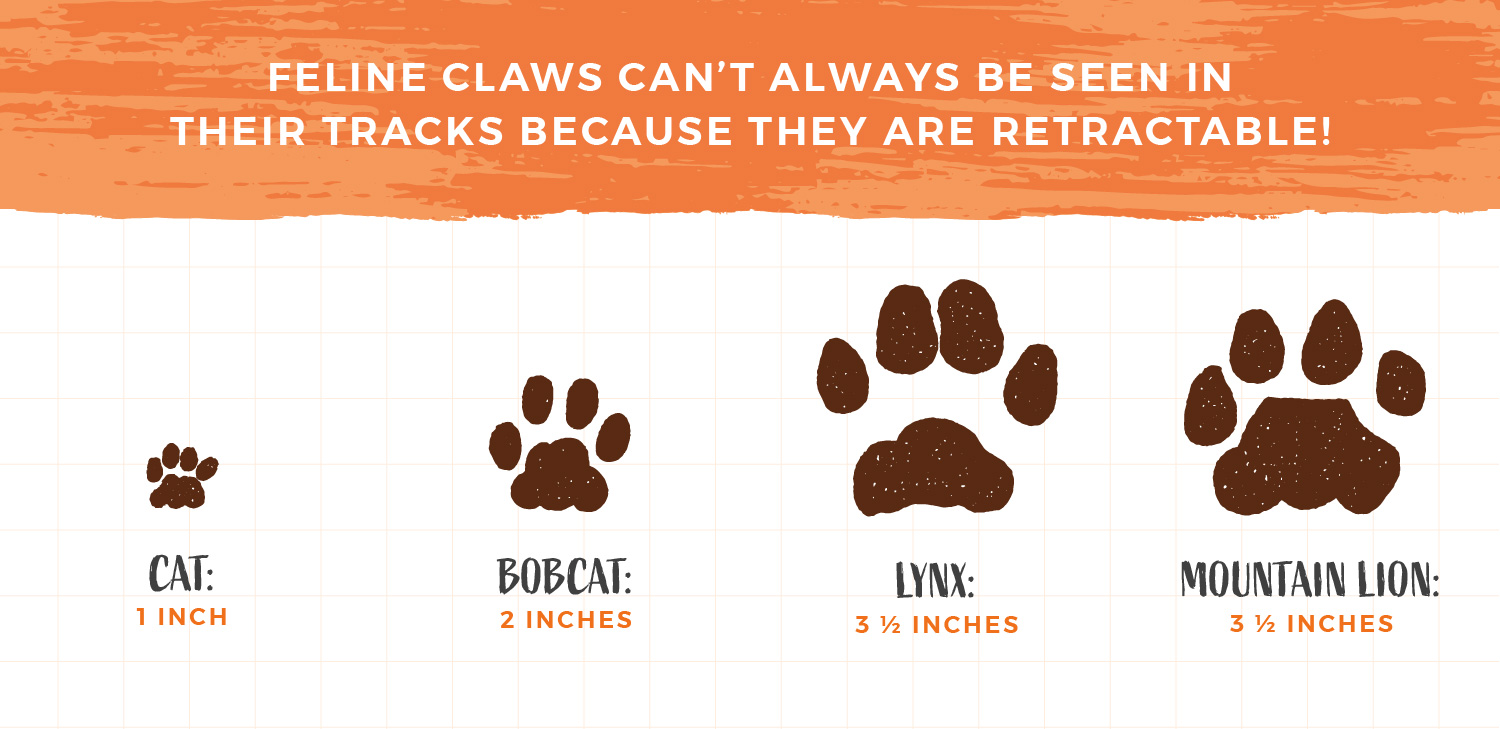
Cat: All felines tend to walk in an alternating pattern and house cat prints are very small –– they’re about the same size as a penny!
Bobcat: Bobcat tracks are around twice the size of house cat tracks and are often confused with dog or coyote tracks when claw marks aren’t visible.
Lynx: These cats are up to 30 pounds in weight and typically have furry paws, obscuring the definition of the foot pad.
Mountain Lion (Cougar): The foot pads of the mountain lion are clearly defined and large compared to a lynx or bobcat.
Small Mammals
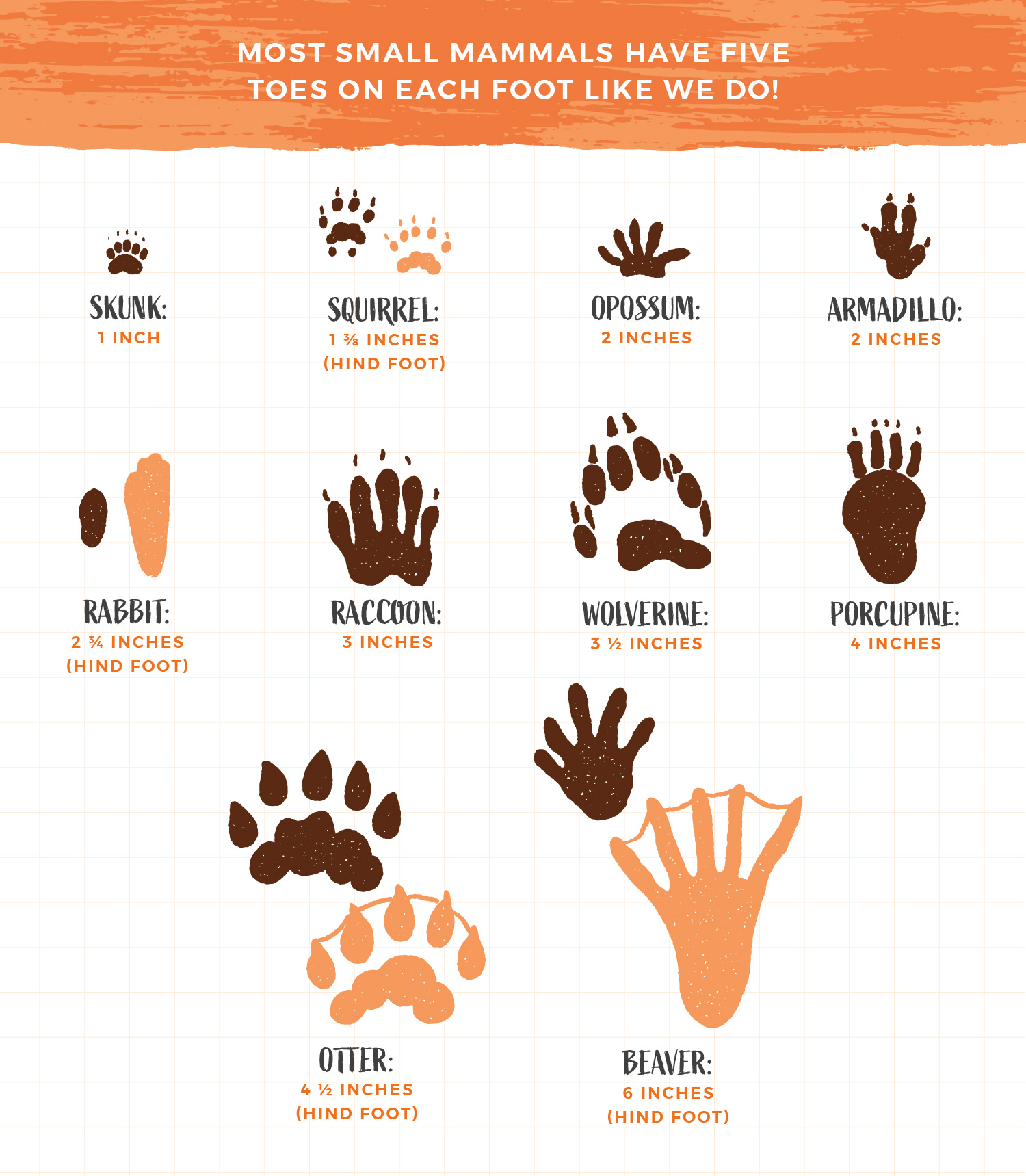
Raccoon: Raccoon tracks closely resemble human hands and feet in miniature –– these mammals waddle when they walk, giving them a unique print placement.
Skunk: Skunks walk with their feet flat on the ground and feature five toes on both front and hind feet –– front feet often show long claw prints.
Opossum: Opossums are the only North American animal to have opposable thumbs (visible in their tracks) and are not actually mammals –– they are the only North American marsupials!
Rabbit: Rabbits and hares have small front feet and long hind feet — their tracks are generally oval in shape with very little detail.
Wolverine: Wolverines have five toes with prints nearly as large as a wolf’s –– they tend to live in remote areas away from humans, so these tracks are rare.
Squirrel: Squirrels leave small footprints with larger back feet and a gait that places their tracks side-by-side in a hopping motion.
Beaver: Beaver prints are nearly impossible to find because of their large paddle-like tails which brush behind them, covering any footprints they may leave.
Porcupine: Porcupines are pigeon-toed, meaning their feet leave prints facing inward –– they have large foot pads with long toes.
Otter: Otter tracks may be seen near river banks in colder climates. Their five-toed feet with webbing may show up in their prints.
Armadillo: Only found in the Southern United States, armadillo tracks show four long toes with sharp claws at the tip –– their scaly tail may drag behind them and cover their tracks.
Hooved Animals
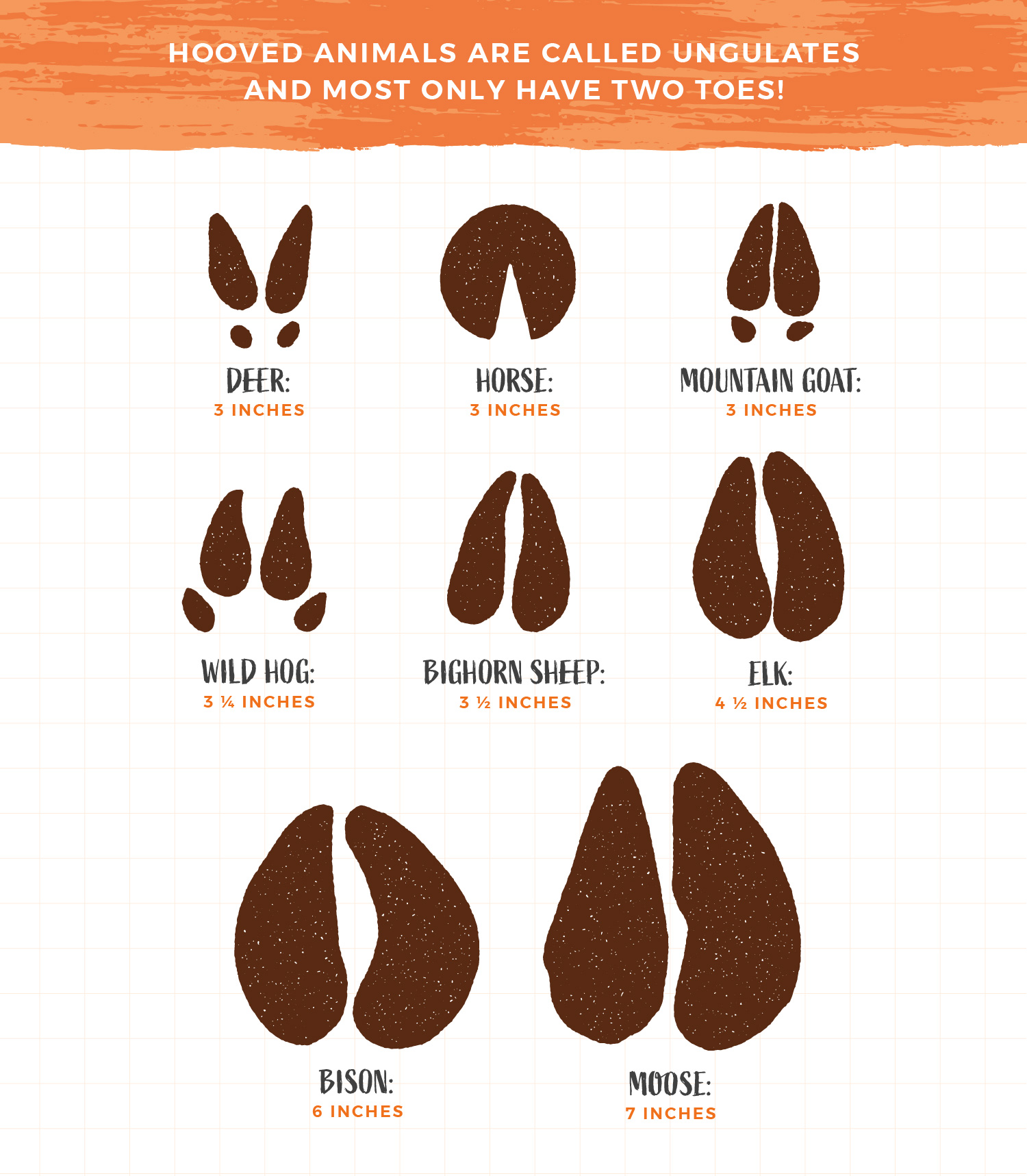
Deer: Deer tracks look like upside-down hearts with two points located towards the inside of the track.
Elk: Elk toes are rounder than deer or moose toes and may sometimes show dew claws when found in deep snow.
Moose: Moose can weigh up to 1,500 pounds and are the largest of the deer family. Like the elk, dew claw prints may be seen in deep snow.
Bison (Buffalo): Bison tracks can be as large as a moose’s but are rounder and less-tapered than other hooved animals.
Horse: Horse hooves are enclosed and circular with a triangular middle portion called a “frog.”
Mountain Goat: Mountain goats have spread-out toes with blunt tips that make it easier to climb steep rock faces.
Bighorn Sheep: Though these may look like deer tracks, bighorn sheep prints are less heart-shaped and less pointed at the toe.
Wild Hog (Javelina): Wild hogs have wide, round toes that do not come to a point –– they also feature dew claws that are more widely set than a deer’s.
Birds

Crow: Crows have three forward-pointing toes, one backward-facing toe and generally create tracks in a hopping motion.
Grouse: Grouse are ground-dwelling birds with no visible backward-facing toe –– their tracks look like backwards arrows.
Wild Turkey: Turkeys are large ground-dwelling birds (males can weigh up to 24 pounds) who leave similar but larger tracks than grouse.
Duck: The webbing on a duck’s foot makes its toe prints appear connected, especially in sand and fine dirt.
Heron: Herons have large four-toed tracks in the classic bird print (three toes pointing forwards and one toe pointing backwards).
Eagle: These tracks feature claw marks that are deeply embedded into the ground –– eagles hardly ever land on the ground, so these tracks are very uncommon.
Reptiles and Amphibians
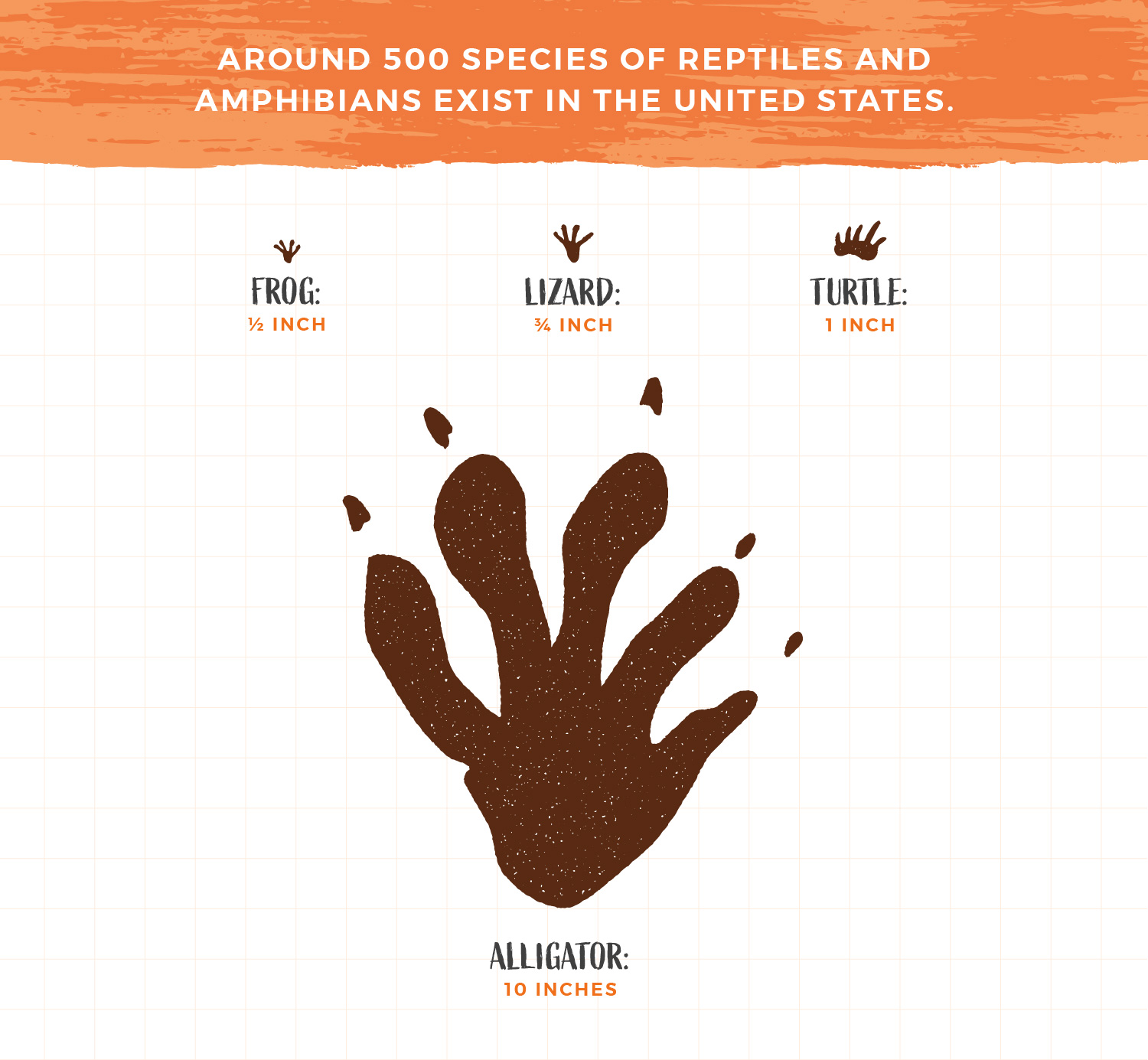
Frog: Frog tracks feature toes with rounded tips and can be distinguished by their hopping gait, which leaves front foot prints inside hind foot prints.
Lizard: Most lizards are very small, so they may leave hardly a trace. While they may leave footprints, you will more likely see a continuous line caused by their dragging tail.
Turtle: When near water, you may see turtle tracks, which are distinguished with claw prints and drag marks caused by the shell.
Alligator: Most common on the Gulf Coast and Florida, alligators leave tracks dominated by a large, continuous tail-dragging print.
Bears
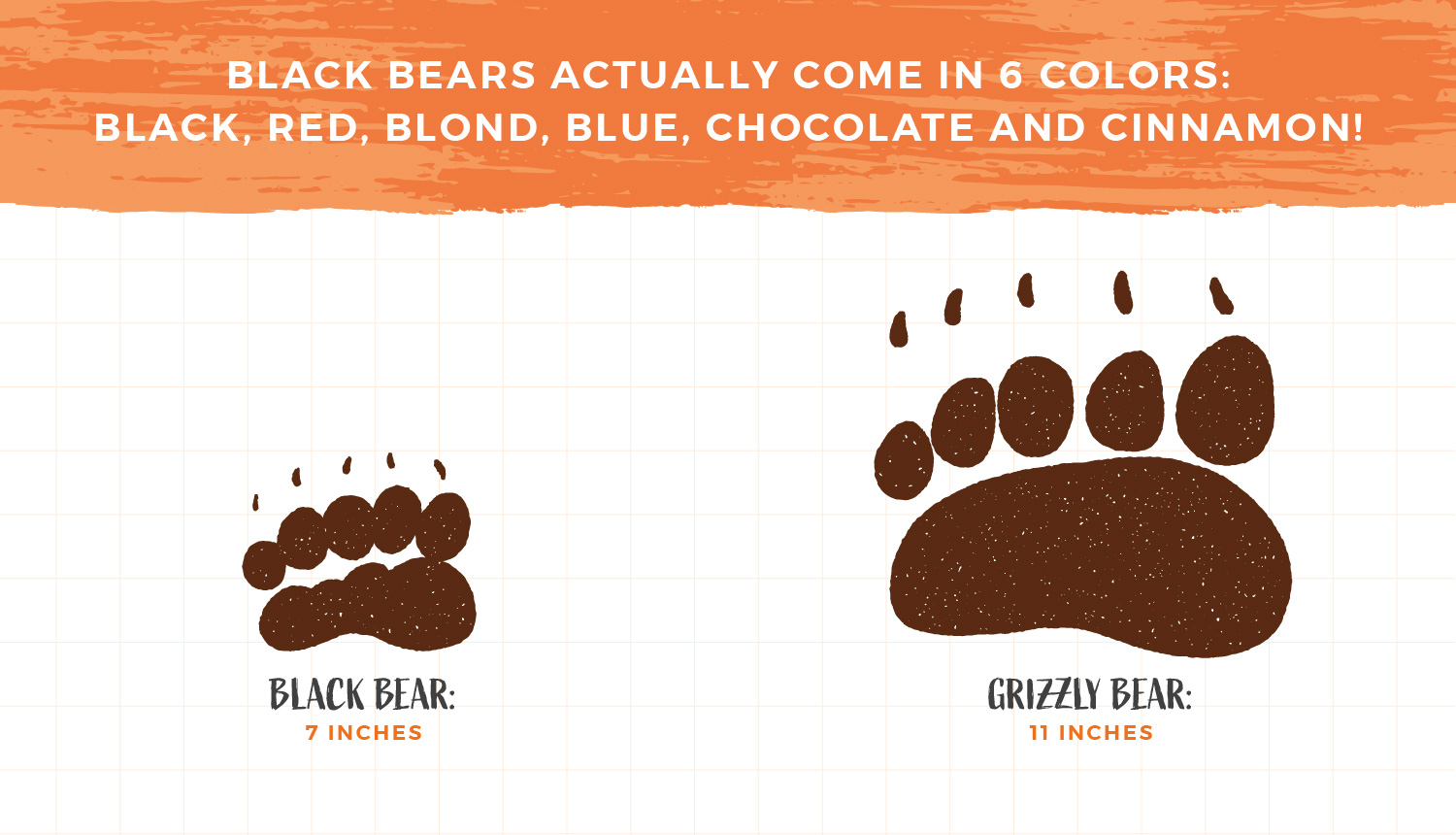
Black Bear: Black bears, commonly found throughout the northern United States and Canada, have short claws and relatively small tracks.
Grizzly Bear: Known for their size, grizzly bear tracks are significantly larger than a black bear’s and feature long, thick claw marks up to four inches in length.
Animal Tracking Activities to Do With the Kids
For animal-loving kids, finding animal tracks can be tons of fun! It’s also a great way to teach your little ones about nature in a hands-on way while helping them practice critical thinking skills and problem solving!
Try these activities with your kids to find tracks and learn about animals:
- Go camping –– Camping out under the stars is a great way to experience nature close up! Ask the kids if they can hear any animals or bugs outside the tent. Listen closely and you may hear an opossum sniffing for snacks, crickets chirping away or the far-away howl of coyotes enjoying the full moon!
- Make a tracking plot –– Create an area in your backyard where you can “catch” animal tracks! Rake a small section of sand or dirt, then leave out a yummy snack like an apple or slice of meat for critters to munch on overnight! Come back in the morning and see what kinds of tracks you can find in the tracking plot!
Try tracking the animals in your area during summer vacation! You’re likely to see all kinds of creatures coming out to play and enjoy the sunshine like you!
No matter where you live, remember to take care of nature when you go outside. Clean up any trash you see and always respect the wildlife around you. Happy tracking!
Sources
Wilderness College | Boys Life | Wolf Conservation Center | U.S. Fish & Wildlife Service | University of Missouri | New Mexico State University | Mississippi Wildlife, Fisheries, & Parks | National Park Service | Bear Tracker | National Geographic



















